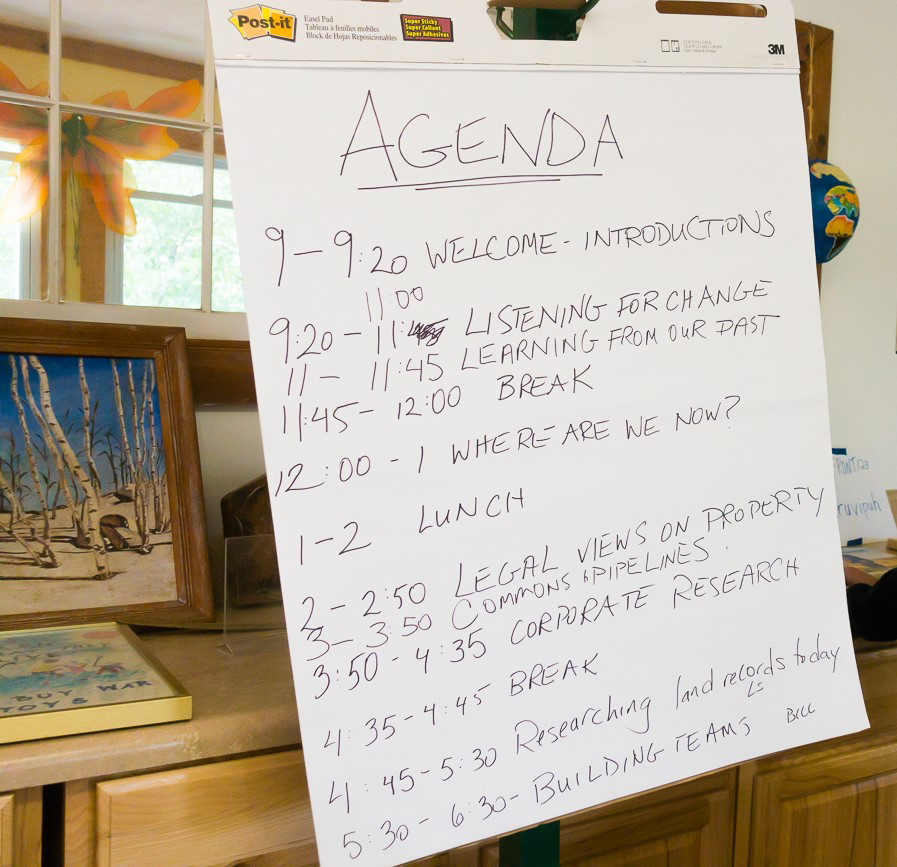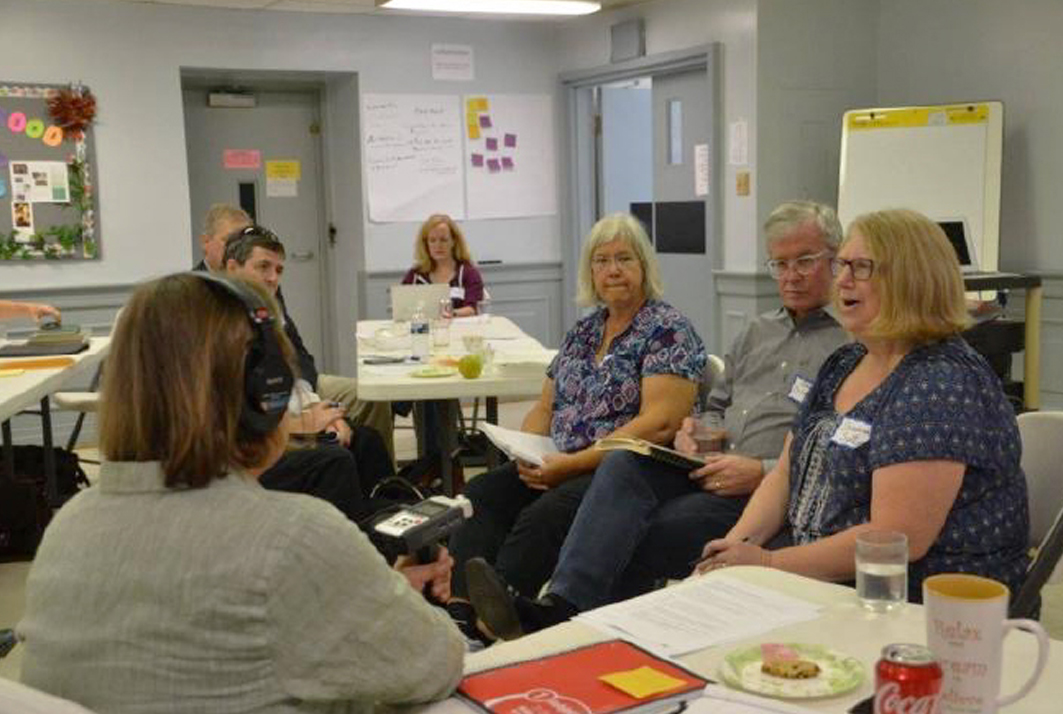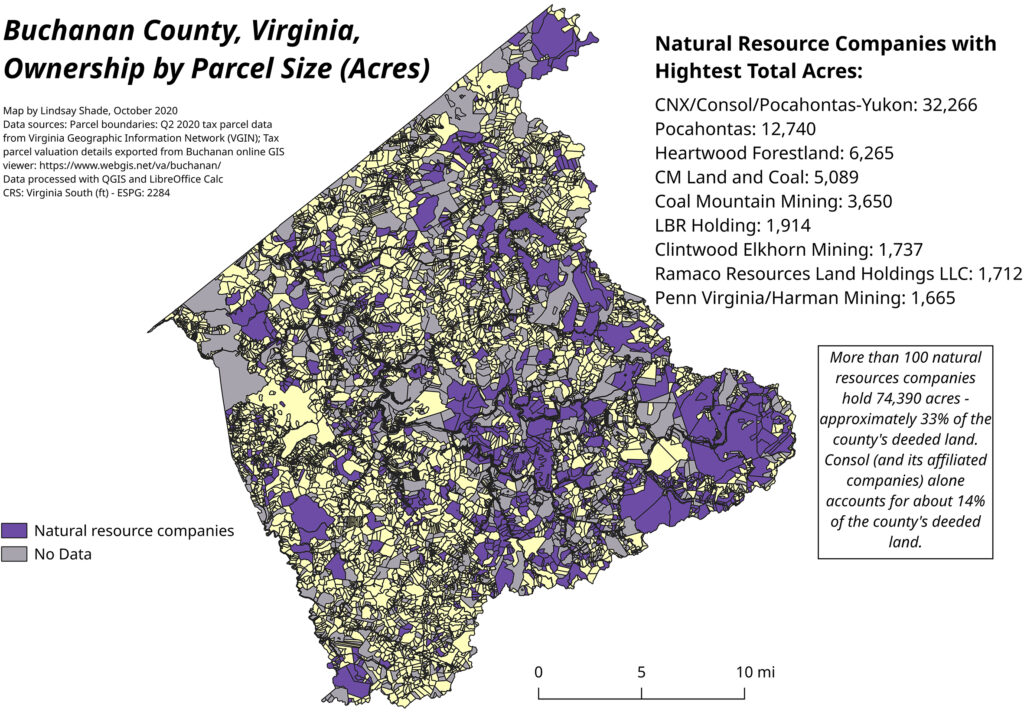June 27, 2024
#17: Methods to Research Land Ownership and Advance Land Justice: The Appalachian Land Study
Reflecting on their work on land ownership in Central Appalachia, Lindsay Shade and Levi van Sant demonstrate the importance of building grassroots knowledge and solidarity through collaborative action research that draws out people’s lived experiences of the land in contexts of deeply entrenched land inequalities and lack of formal land data. Their innovative approach helps improve access to information about land and land records, and uses critical GIS approaches to visualize inequalities in land tenure and public revenues.
***
Introduction
Our research in coal, oil, and gas affected areas of Central Appalachia examines the legacies of concentrated land ownership and declining public revenues associated with natural resource industries. We also aim to uncover trends in rural land ownership change as energy transitions, financialization of farm and forest land, and rural gentrification all contribute to dynamic land markets in what may otherwise appear as “sleepy” or even declining rural economies. We argue that there are significant opportunities to apply rigorous empirical research on rural land ownership to address major contemporary social, economic, and environmental challenges. However, our research experience also demonstrates that current systems for managing and accessing public data about US land ownership are lacking and present a number of challenges to empirical studies of ownership (Shade and Van Sant 2023) [1].
Why land ownership?
Land ownership research has the potential to unveil key dynamics of persistent inequalities, since property ownership provides political influence and is a mechanism for the transfer of generational wealth (Du Bois 1992 [1935] [2]; Christophers 2018 [3]). Property taxes are a crucial source of public revenues, and inequalities in ownership and taxation therefore have cascading socio-economic impacts on counties and municipalities. Land is also the material basis for society and economy; the legal systems that govern land ownership and access are therefore crucial mediators of all social, cultural, and economic processes connected to land (Sundberg 2004 [4]; Mollett and Faria 2013 [5]). Property rights are a basis of capitalist accumulation and articulate the linkage between state-territorial governance and citizenship (Polanyi 1944 [6]; Blomley 2016 [7]; Jacobs 2020 [8]). Interrogating land ownership patterns, inequalities, and public revenues from property can therefore ground a range of theoretical work in political economy and socio-ecological dynamics. Our work is especially driven by the ways in which the study of land ownership can immediately support struggles for land justice (Williams and Holt-Giménez 2017 [9]; Horst and Marion 2019 [10]).
The Appalachian Land Study
Much of our experience comes through a participatory project known as the Appalachian Land Study, which is inspired by a previous study jointly led by scholars and activists in the wake of the first onslaught of strip mining in the region (ALOT 1983) [11]. Landholding in the Appalachian region is characterized by centuries of land grabs by absentee speculators associated with resource extraction economies, including timber, coal, oil, and gas. The combination of resource-dependent economies with a landholding structure that squeezes availability of land for residential and local business development has shaped class formation and resulted in persistent systemic inequalities. The resulting corporate and elite capture of local political and administrative institutions, including those that govern land records and property tax systems, have generated lopsided public revenue systems in which local residents shoulder the majority of the tax burden but control a paucity of land (see next section). At the same time, civic space and discourse are choked out, especially since the decimation of unions beginning in the 1980’s and 1990’s. Mechanization, strip mining, and mountaintop removal coal mining significantly reduced the labour force and increased competition for jobs, while the industry-sponsored astroturf organization Friends of Coal successfully linked Appalachian identity with extractive industry and opposition to environmentalism (Bell 2016) [12]. These dynamics produce unique challenges to working across ideological differences to address land issues in the region. Therefore, the work of the Appalachian Land Study project is to build grassroots knowledge and solidarity through collaborative action research that draws out people’s lived experiences of the land, works to improve access to information about land and land records, and uses critical GIS approaches to visualize inequalities in land tenure and public revenues.
Methods and Findings
Following the model of its predecessor, the Appalachian Land Study employs participatory methods in recognition of the inherently political nature of land ownership research. Participatory action research facilitates participation, action, and reflection by those most impacted by the research and its themes (Fals-Borda 1987) [13]. The Appalachian Land Study draws on the transformative potential of people’s connection to land and place, which opens pathways for political dialogue in areas where civic space has been severely undermined by two centuries of corporate domination.
Our process began with an online survey, widely distributed through organizational and academic contacts and listservs, followed by a forum of 65 academics and community activists in late 2016. The forum was held in Lexington, Kentucky and sought to develop a vision. Many other meetings, conference calls, and emails over a listserv with more than 200 participants followed. These all shaped the study’s goals and methods, with early emphasis on establishing shared values to guide the vision and framework. In these early stages, professional facilitation and participatory exercises to draw out people’s common knowledge, concerns, and questions were critical to establishing research objectives and approaches that reflect broad regional problems.
Agenda from a regional training and workshop held in Pipestem, West Virginia in 2017. Source: Hope Hart
The overarching objective that emerged from the participatory design process is to gather accurate data about land and mineral ownership and public revenues in order to address root causes of inequality and support just transition in Central Appalachia. While members of the collective are concerned with diverse place-based research questions, stakeholders across the region want to know who the primary owners of land are in their respective counties and how they contribute to and influence public revenues. For myriad reasons, this data can be surprisingly challenging to access and analyse in under-funded rural counties. Because deed books are rarely digitized and do not contain data in a form that is easy to analyse, we have found that public property valuation assessment (PVA) records are the best available proxy for researching ownership trends. Yet, the quality and availability of these records are highly variable: there is no standardization between counties, or even within counties– as record administrators change, so too do the standards and practices of record-keeping. Moreover, many counties and states do not have GIS or sophisticated digital property valuation databases. We have found partnerships between academic researchers and locally informed rural residents necessary to gather, interpret, and translate land records into useful maps and statistics that can inform policy proposals and serve as a springboard for public discussions about who owns land.
A panel discussion with participants of the 1979 Appalachian Land Ownership Task Force, held at the 2016 launch meeting. Source: the authors (persons pictured with permission). This panel discussion was also turned into a podcast, available at: https://soundcloud.com/mountaintalkmonday/mtn-talk-who-owns-appalachia-then-now
On the other end of the spectrum, states such as North Carolina and Tennessee have implemented robust, centralized state GIS systems. The consistency and quality of data in North Carolina has facilitated more rapid and complex statistical analyses. For instance, Lindsay Shade worked with a graduate student at Appalachian State University to gather PVA data from 29 western North Carolina counties, code for absentee ownership based on zip code, and calculate a Gini coefficient and Lorenz curve for ownership inequality in each county (Meadows 2018) [14]. These data can be paired with data about absentee ownership and socioeconomic indicators to further characterize the impacts of ownership inequalities. Building on the collective knowledge of land study researchers in both academic and grassroots venues, we also crafted an interview guide to gather qualitative data from local tax assessors. These interviews provide a richer context through which to interpret quantitative findings, and are also important for documenting the qualitative dimensions of property as a product of mundane human activities, such as record-keeping practices, which are integral to both the emergence and maintenance of systems of landed property (Rose 1985 [15]; Bhandar 2018 [16]).
The early work in framing and designing the study served an important role in networking diverse stakeholders not as mere recipients of data and information but as active partners in co-producing knowledge and action. As work has shifted to more local implementation, the organizing structure evolved to a smaller collective of individuals from Tennessee, Virginia, West Virginia, and Kentucky who are connecting quantitative data about land ownership and public revenues with qualitative stories of place and local and state policy proposals. For example, Terran Young, a journalist from southwest Virginia who completed a fellowship with the land study, collected oral histories about the erasure of Black communities in Wise County, Virginia which she presented in a series of community dialogues about land ownership. Since then, maps and data gathered through the land study have been presented in seven southwest Virginia counties at public meetings about the role of land in economic justice. Through the findings developed in these meetings, the Southwest Virginia New Economy Network has been fighting for equitable access to land, including a legislative proposal for an excess acreage tax to be assessed on the largest landowners. In addition to more evenly balancing local property tax burdens and raising much needed public revenues, excess acreage taxes may also incentivize landholders to break up or sell off parcels that are underutilized.
Natural resource company ownership of land in Buchanon County, Virginia. Source: Authors, available at:https://appvoices.org/2020/12/11/fighting-for-equitable-land-access-in-southwest-virginia/
Conclusion
Critical engagement with land records and participatory methods that prioritize the insights of rural people in resource-based economies can both document and respond to the dynamics of U.S. land ownership. While we have focused on Appalachia, the methods are much more broadly applicable – a firm grasp on who owns the land can inform a range of economic, environmental, and cultural geographic inquiries. From rapidly changing land and commodity markets to mundane legal transactions such as mergers and acquisitions (or even the recent divorce proceedings of Bill and Melinda Gates [17]) land ownership is always in flux and therefore inherently challenging to document. We attempt to deal with this complexity by approaching records as material artifacts, while simultaneously utilizing available data to elicit public engagement about entrenched inequalities. In this moment of overlapping political, economic, and ecological crises, we are hopeful that more land ownership research will engage diverse publics with difficult questions about who can access, make decisions about, and benefit from land.
[1] Shade L, and Van Sant L (2023) Geographies of Land Ownership Change in the Rural United States: Challenges, Methods, and Possibilities. The Professional Geographer 75(5): 844-854. doi:10.1080/00330124.2023.2194367 [2] Du Bois W.E.B. (1992 [1935]) Black Reconstruction in America. New York: Atheneum. [3] Christophers B (2018) The New Enclosure: the Appropriation of Public Land in Neoliberal Britain. London: Verso. [4] Sundberg J. (2004). Identities-in-the-making: Conservation, Gender, and Race in the Maya Biosphere Reserve, Guatemala. Gender, Place and Culture: A Journal of Feminist Geography. 11(1): 44-66. Doi: 10.1080/0966369042000188549 [5] Mollett S and Faria C (2013) Messing with Gender in Feminist Political Ecology, Geoforum, 45, pp. 116–125. [6] Polanyi K (1944) The Great Transformation. New York: Farrar and Rinehart. [7] Blomley N (2016) The Territory of Property, Progress in Human Geography, 40(5), pp. 593–609. [8] Jacobs H (2020) Whose Citizenship? Social Conflict over Property in the United States. Social Policy and Society 19 (2):343–55. [9] Williams JM and Holt-Giménez E (eds) (2017). Land Justice: Re-imagining Land, Food, and the Commons. San Francisco: Food First Books. [10] Horst M and Marion A (2019) ‘Racial, Ethnic and Gender Inequities in Farmland Ownership and Farming in the U.S.’, Agriculture and Human Values, 36(1), pp. 1–16. [11] Appalachian Land Ownership Taskforce (ALOT) (1983) Who Owns Appalachia? Landownership and its Impact. Lexington: University Press of Kentucky. Accessed March 12, 2024. https://uknowledge.uky.edu/upk_appalachian_studies/8/. [12] Bell SE (2016) Fighting King Coal: The Challenges to Micromobilization in Central Appalachia. MIT Press. [13] Fals-Borda O (1987) ‘The Application of Participatory Action-Research in Latin America.’ International Sociology 2 (4):329–47. doi: 10.1177/026858098700200401. [14] Meadows J (2018) ‘Who Owns North Carolina: Econometric, Geospatial, and Interview Analyses of Land in Appalachian North Carolina for Land Policy Reform in the Appalachians: A Research Design and Findings to Date.’ West Virginia Law Review 120:1089–1106. Accessed December 9, 2022. https://researchrepository.wvu.edu/wvlr/vol120/iss3/17. [15] Rose C (1985) ‘Possession as the Origin of Property.’ The University of Chicago Law Review 52 (1):73–88. [16] Bhandar B (2018) Colonial Lives of Property: Law, Land, and Racial Regimes of Ownership. Durham: Duke University Press. [17] Kulish, N., Gelles, D., Das, A., and Kelly, K. (2021, Aug 2). The Gateses’ Public Split Spotlights a Secretive Fortune. The New York Times. https://www.nytimes.com/2021/05/13/business/bill-melinda-gates-divorce.html


